The latest LED lights make a perfect replacement for traditional incandescent light bulbs.
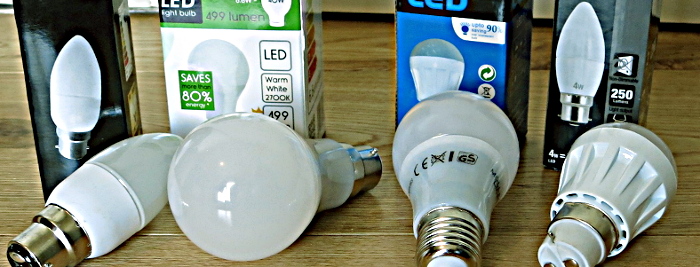
TLT member Nick Talbott has written a guide to choosing LED bulbs based on their experience of making the switch to all LED lighting in their new home.
The latest LED lights make a perfect replacement for traditional incandescent light bulbs. In refurbishing our new home to achieve near Passivhaus standards we have used LED bulbs and fittings throughout. In this article I'll share our experience and offer some suggestions for choosing LED bulbs.
First, a bit of history...
First generation Low Energy bulbs - CFLs
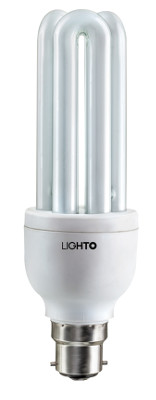 The first generation of low energy light bulbs were compact fluorescent lamps (CFLs). The main advantages these had over incandescent bulbs were reduced energy use – typically using one fifth of the electricity – and a much longer life. These features made them a clear cost-effective choice for lighting. But CFL bulbs did have their downsides.
The first generation of low energy light bulbs were compact fluorescent lamps (CFLs). The main advantages these had over incandescent bulbs were reduced energy use – typically using one fifth of the electricity – and a much longer life. These features made them a clear cost-effective choice for lighting. But CFL bulbs did have their downsides.
- Most CFLs have a delay after switching on, and often take a minute or more to reach their full brightness.
- CFLs are usually larger than the equivalent traditional bulbs they replace, and it can be hard to find CFLs that are small enough to use in fittings designed for "golf ball" or "candle" light bulbs.
- Some find the quality of light from CFLs is a little harsh, lacking the warmth of traditional bulbs.
- There are small amounts of mercury in every CFL bulb, requiring special care in disposal (they should not be put out with normal household rubbish).
More modern CFLs have gone a long way to addressing these concerns, but lights based on LED technology are now able to provide a better solution to most lighting needs.
LED light bulbs
LED lighting technology is improving all the time. Prices have fallen rapidly over the past couple of years, and the latest bulbs have overcome the early limitations of low light output or poor light quality. They are available in a range of sizes and light output levels and with suitable fittings to meet the vast majority of domestic lighting requirements.

LEDs are still more expensive than CFLs for the equivalent light output, but the benefits they offer are:
- lower energy use – typically one tenth of the electricity of an incandescent bulb, or half that of a CFL bulb
- "instant on" - LEDs come on as soon as you flick the switch and give their full brightness straight away
- longer life – LEDs claim a theoretical life of 20 to 30 years, though this does depend on how they are used and on the quality of manufacturing
- light quality that closely matches traditional incandescent bulbs, provided you purchase LED bulbs with a suitable colour temperature
- smaller size than CFLs, with recent designs now able to match the size and appearance of traditional "candle" and "golf ball" size bulbs.
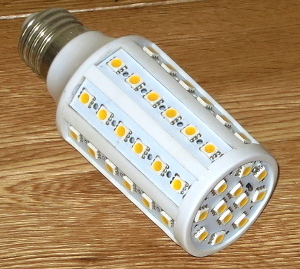 LED bulbs combine a number of individual LEDs within a bulb-shaped housing. In general, the more individual LEDs, the more light is produced.
LED bulbs combine a number of individual LEDs within a bulb-shaped housing. In general, the more individual LEDs, the more light is produced.
Here is a picture of an earlier style "corn" bulb (christened due to an appearance not unlike a corn cob). It uses 60 individual LEDs to produce a light output roughly equivalent to a 60 watt incandescent bulb. However, with technical development the amount of light that an individual LED can produce has been increasing significantly.
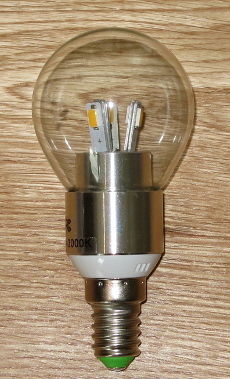 The other light bulb shown here is a recent design using only 6 individual higher output LEDs which produces light roughly equivalent to a 40 watt incandescent bulb.
The other light bulb shown here is a recent design using only 6 individual higher output LEDs which produces light roughly equivalent to a 40 watt incandescent bulb.
LEDs operate at low voltage, so light bulbs have to accommodate the necessary electronic components to transform mains voltage down to the 12 volts typically used by LEDs. The need to include the transformer in the bulb is the main constraint on size of LED light bulbs.
LED colour temperature
When choosing an LED bulb, the colour temperature of the light is important. Early LEDs generally produced a "cool white" light with a noticeable blue tinge. For indoor lighting, most people prefer the warmer, slightly orangey light of a traditional incandescent bulb. LEDs are now available that produce this warm colour, but the neutral or cool white LEDs can still be preferable for task lighting such as in kitchen downlighters or desk lights. You need to choose the colour that works best for you.
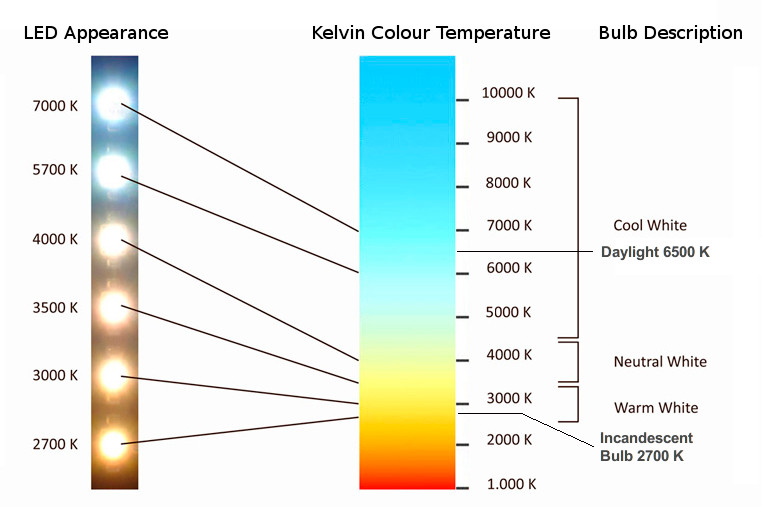
LED bulbs are available for use with dimmer switches. Dimmable LEDs typically cost a lot more than non-dimmable bulbs, and you usually need to use dimmer switches that are intended for use with LED bulbs. So LED bulbs may not be a simple replacement if you currently use an incandescent bulb with a dimmer switch.
LED lighting used at Trosnant
We have used a mixture of LED downlight fittings and various LEDs bulbs fitted to conventional light fittings and free-standing lamps. Initially we bought individual bulbs from different suppliers to see which worked best. We've not (yet) tried any dimmable LED bulbs ... where required we can vary lighting levels in a room by switching on more or fewer lights.
In most rooms we find a single 7watt LED bulb in a conventional central pendant light fitting is fine for general lighting. Subjectively I would say these look like brighter than a 75watt incandescent bulb but not quite as bright as a 100watt bulb. 6watt downlighters are good for task lighting. We initially tried 9watt downlighters, but we found these to be a bit too bright!
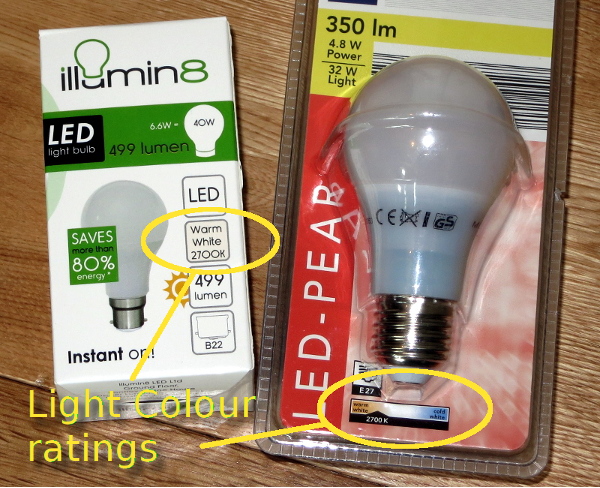 The first batch of LED bulbs we bought for general room lighting were correctly described as "warm white", with a colour temperature of 3000K. While this is at the "warm" end of the colour range, there is a noticeable difference between these bulbs and the ones we have bought recently from Illumin8 which have a colour temperature of 2700K.
The first batch of LED bulbs we bought for general room lighting were correctly described as "warm white", with a colour temperature of 3000K. While this is at the "warm" end of the colour range, there is a noticeable difference between these bulbs and the ones we have bought recently from Illumin8 which have a colour temperature of 2700K.
We have noticed that manufacturers are now starting to show the colour temperature on packaging as well as the more general classification of "warm" or "cool" and this makes it easier to get the colour of light you want.
A word of caution, though... In some LED downlighters we purchased there is a variation in the colour of the light produced between individual units even though they all had the same specification. This may be because they came from different manufacturing runs and/or used slightly different components. So if you need a number of bulbs to be a consistent colour (for example where you have a light fitting that takes more than one bulb) it may be a good idea to buy them all at the same time.
The other noticeable improvement we have seen with the more recent LED bulbs we have bought is in the spread of light. The earlier bulbs have the actual LEDs on a flat disk, so the light tends to be projected more downwards than to sides or above. This produces a different lighting pattern to a traditional bulb.
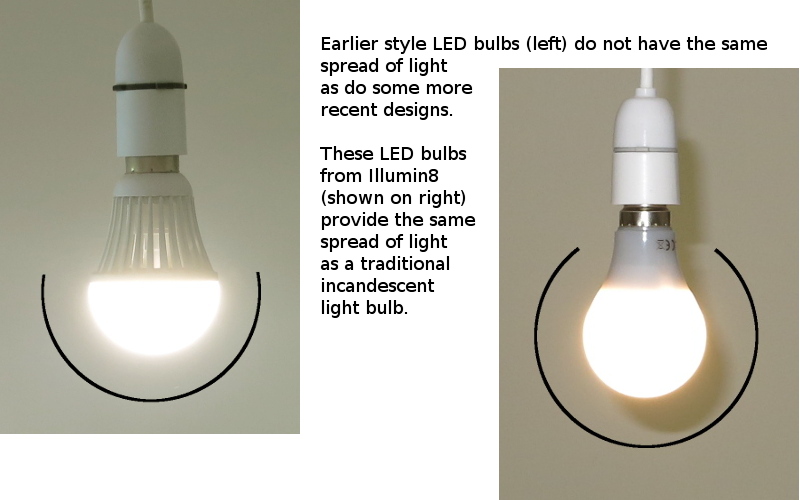
The more recent bulbs we have bought (locally from Aldi and mail order from Illumin8) have a different arrangement of the LEDs which produces a fully dispersed lighting pattern which we prefer. If you look at the way the LEDs are arranged in the clear bulb shown earlier you can see how this would result in a much wider spread of light than having all the LEDs on a flat disk.
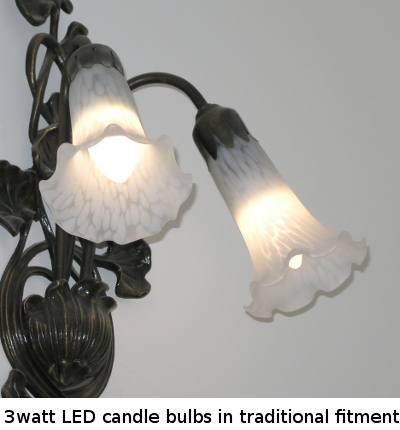 As well as conventional shape bulbs, we have also needed to use "candle" style bulbs in some fitments. Because LED bulbs can be made the same size and shape as the incandescent bulbs for which the fitment was originally designed, LED bulbs work really well.
As well as conventional shape bulbs, we have also needed to use "candle" style bulbs in some fitments. Because LED bulbs can be made the same size and shape as the incandescent bulbs for which the fitment was originally designed, LED bulbs work really well.
Cost and Reliability
LED bulb prices have fallen quickly over recent years and are widely available from under £5 a bulb.
If you were to replace a single 60 watt incandescent bulb used for an average of 5 hours a day, an LED bulb would save at least £12 a year in electricity costs. However, if you are considering replacing a CFL bulb, the savings from switching to LED would be less – not much more than £1 a year. There are, of course, the other benefits from using LED bulbs that might make you decide the change is justified.
So while switching from using an incandescent or halogen bulb to LED will pay for itself within a few months, the financial case for switching from a CFL to LED is less clear. The LED bulb would have to last for more than 4 years before the savings would recover the cost of switching.
We've experienced 2 failures of an LED bulb in three years. The first one failed after around 6 months and was replaced at no cost under warranty. The second one failed recently and was just outside the one year warranty period from the supplier. A quick search on the web will show that it is not uncommon for LED bulbs to fail well before reaching their theoretical life expectancy.
Some distributors are now offering a 10-year warranty on LED bulbs, but between 1 and 3 years is more typical. If you already use CFL low energy lights, you may want to look for a decent warranty in order to make sure you do make a cost saving from changing. But beware... online suppliers offering long warranties often charge a lot more for their bulbs. I have seen what appears to be the same bulb that is widely available for under £5 being sold for over £12 at online suppliers offering a 5 year warranty. So do shop around before buying, specially if buying in quantity. You may be better off buying a few spares rather than paying inflated prices for a long warranty.
Another consideration relating to the life of LED bulbs is the number of "switching cycles" the bulb is designed to handle. Taking as an example the Illumin8 A60 bulb, the specification for this bulb gives a theoretical life of 30,000 hours, which is over 27 years if on for 5 hours a day. But the specification also gives the life as 20,000 switching cycles. So if the bulb were to be used somewhere it is frequently switched on and off this would be the limiting factor. For example, if used in a WC where it might be switched on and off 20 times a day, then the life would be 1000 days, or under 3 years, even though the bulb might only be on for a small fraction of its rated life.
Conclusions and Recommendations
 Most visitors to Trosnant don't realise the lights we use are LED bulbs until it's pointed out. That's how good modern LED bulbs have become.
Most visitors to Trosnant don't realise the lights we use are LED bulbs until it's pointed out. That's how good modern LED bulbs have become.
If you have no previous experience of using LED bulbs, try out one or two and see how you like the quality of light. If you like the look of traditional lighting, buy a bulb which specifies the light colour somewhere around 2700K. We're very happy to recommend the bulbs we've recently had from Aldi (branded "Muller Licht") and Illumin8, both of which are 2700K. These certainly have the most pleasing light colour and lighting spread of any bulbs we've tried out.
TLT members are welcome to visit Trosnant (when it's dark!) to see how our LED lights work. We'd also be happy to lend you the odd LED bulb from our spares supply for you to try out.